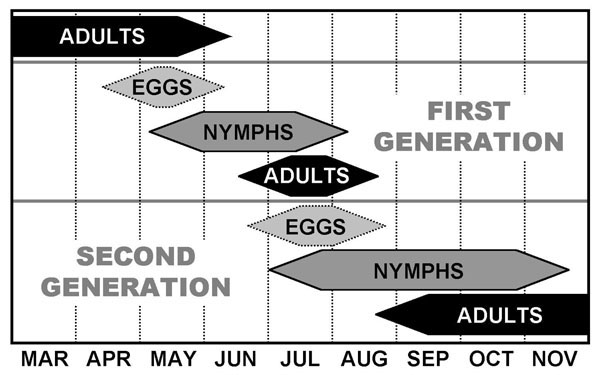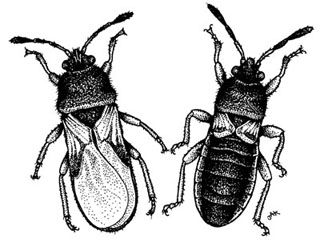G1952
Chinch Bugs in Buffalograss and Zoysiagrass Turf
This guide discusses the biology and management of western chinch bugs.
Frederick P. Baxendale, Extension Entomologist
Mitchell D. Stamm, Research Technician
Tiffany M. Heng-Moss, Assistant Professor
|
Over the past decade, the western chinch bug, Blissus occiduus, (Figure 1) has become a serious insect pest of buffalograss turf in Nebraska. First detected infesting a heavily damaged buffalograss lawn in Lincoln, Nebraska in 1989, these chinch bugs have subsequently been found associated with buffalograss throughout Nebraska and surrounding areas.
More recently, western chinch bugs have become a serious pest of zoysiagrass. Beginning in the summer of 2000, numerous zoysiagrass lawns in southeast Nebraska have been extensively damaged by this turfgrass pest.
Recent studies at the University of Nebraska–Lincoln have shown that western chinch bugs have an extensive host range which includes several turfgrasses: buffalograss, zoysiagrass, Kentucky bluegrass and perennial rye; field crops: wheat, barley, rye and sorghum; and several grassy weeds: green and yellow foxtail.
While all of these grasses have the potential to be damaged by western chinch bugs, buffalograss and zoysiagrass are clearly the chinch bug’s preferred hosts and are the most likely to develop an infestation.
Western chinch bugs overwinter as short-winged adults in and around the turf area. In early spring, adults emerge from overwintering sites, mate and deposit their eggs in the crowns of plants or in the underlying soil. Eggs hatch during mid- to late May.
First stage nymphs are tiny (about 1/64 inch long), bright red insects with a white band across the abdomen. As nymphs mature, their color changes to orange-brown and finally to black.
Adults of the first summer generation begin to appear in late June or early July. They are black and about 1/10 inch long. (Females are slightly larger than males.) A significant proportion (up to 50 percent) of the adults in this generation have fully developed wings which extend to the end of the abdomen. These winged adults are capable of dispersing to new feeding sites. The remainder of the adults in this generation appear wingless, although very short wing stubs are actually present.
First stage nymphs of the second summer generation hatch from eggs during mid- to late July, and complete development in September and early October. Adults of this second generation are predominately short-winged and overwinter in or near the turf area. Figure 2 shows the life history of western chinch bugs in Nebraska.
 |
| Figure 2. Life history of the western chinch bug, Blissus occiduus. |
Chinch bugs injure grasses by withdrawing sap from plant tissues in the crown area. While feeding, they also may inject a salivary toxin that damages plant tissues and inhibits the translocation of water and nutrients. Initially, this feeding results in reddish-purple discoloration of the leaves. In the lawn or turf stand, damage appears as patchy areas which turn yellow and dry to a straw-brown color as feeding progresses. At higher infestation levels, chinch bug feeding can result in severe thinning or death of the turfgrass stand. Chinch bugs can be detected by removing a small section of turf and vigorously shaking it over a sheet of white paper to dislodge the insects. You can also detect chinch bugs by removing both ends from a 2-lb metal coffee can, pressing it firmly into the ground in an area with a suspected chinch bug infestation and filling the can with water. Chinch bugs will quickly float to the surface where they can be identified and counted. If chinch bugs are estimated to exceed 20-25 per square foot (five coffee cans = one square foot) of turf and feeding damage is apparent, control measures are likely to be required.
The best defense against chinch bugs are sound cultural practices to keep the turf stand in optimal condition. Since these insects prefer turf areas high in thatch and organic debris, cultural and mowing practices minimizing thatch accumulation should discourage initial infestations and also may help reduce existing chinch bug problems.
A second approach for deterring western chinch bug infestations involves planting chinch bug-resistant turfgrasses. Research at the University of Nebraska–Lincoln has shown that the seeded buffalograss cultivar, Cody and Tatanka, and the vegetatively propagated cultivar, Prestige, are moderately to highly resistant to western chinch bug feeding. It’s important to remember, however, that heavy chinch bug infestations can damage even these resistant turfgrasses.
Because the host range of western chinch bugs include several important field crop and weed species, regularly monitor areas where buffalograss or zoysiagrass border these potential grass hosts for chinch bug activity. Not only can these hosts serve as chinch bug reservoirs, they also can be seriously damaged if the primary host (buffalograss, zoysiagrass) is heavily damaged by chinch bug feeding.
Insecticide efficacy trials conducted at the University of Nebraska–Lincoln indicate that bifenthrin (Talstar, Ortho Bug-B-Gon), lambda-cyhalothrin (Spectracide Triazicide), or carbaryl (Sevin), applied in 3 to 5 gallons of water per 1,000 square feet, should provide acceptable chinch bug control.
Prior to treatment, mow the turf to a height of 1 1/2 to 2 inches and remove the clippings. This will minimize interception of the insecticide by the turf canopy.
Immediately following application, irrigate the treated area with 1/8 inch of water to wash the insecticide off grass blades and down into plant crowns and thatch where chinch bugs are feeding. If a granular insecticide is applied, irrigate the turf with at least one-fourth inch of water to activate the insecticide.
In areas where chinch bug numbers are very high, two insecticide applications may be required to achieve satisfactory control. Typically, the first treatment should be applied during mid-June and the second in late July.
This publication has been peer reviewed.
Disclaimer Reference to commercial products or trade names is made with the understanding that no discrimination is intended of those not mentioned and no endorsement by University of Nebraska–Lincoln Extension is implied for those mentioned. |
Visit the University of Nebraska–Lincoln Extension Publications Web site for more publications.
Index: Insects and Pests
Other Pests
Issued May 2009
